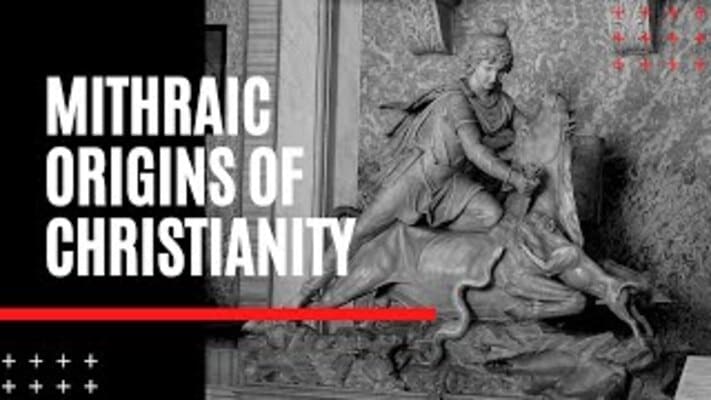Paul And The Pagan Religion of Mithraism, Mystery Solved
Though scholars at the turn of the 20th century understood that Christianity was heavily influenced by Mithraism, there is a recent trend among Christian apologists and revisionist academics to deny this historical debt to paganism. As a case in point, Christian historian Justo Gonzales makes the following remark to refute earlier scholarship on the subject in his 1970 book “A History of Christian Thought”,
Volume I:
“Concerning the relationship between the mystery cults and Christianity, scholarly opinion has varied. During the first two or three decades of the twentieth century, it was thought that the mystery religions constituted a unity based on a common ‘mystery theolgoy,’ and that Christianity was simply one of them, or at most, a distinct religion is which the influence of the mysteries was greatly felt. According to the scholars of that time [e.g., W. Bousset, A. Loisy and R. Reitzenstein], Christianity had taken from the mysteries its rites of initiation—-baptism, its sacramental meals—communion; its ascending stages of initiation—-the orders; and a multitude of details needless to enumerate. But since then, a careful study has been made of the mysteries, and the conclusion reached by almost all scholars is that there was no such thing as a common ‘mystery theology’—at least in the first century of our era. Quite the contrary, the mystery cults differed one from another so much that it is difficult even to explain the term ‘mystery religion.’ Moreover, the mysteries seem not to have reached their full development until the second and third centuries, which is the time when the majority of their characteristics in common with Christianity appear. It follows that such traits can be more easily explained as the influence of Christianity on the mysteries than the opposite, the more so when we learn that already in this period the pagan cults tried to imitate some of the characteristics of the dynamic new faith.”
Gonzales based his refutation on a chronological argument. It is a common belief that Mithraism did not enter the Roman world until well after Paul’s lifetime. Alison B. Griffith, for example, says that “the evidence also indicates that at least some inhabitants(or Rome and its port city Ostia) knew about Mithraism as early as the late first century CE, but that the cult did not enjoy a wide membership in either location until the middle of the second century CE.” Similarly, the Britannica observes that “there is little notice of the Persian god in the Roman world until the beginning of the 2nd century, but, from the year AD 136 onward, there are hundreds of dedicatory inscriptions to Mithra.” Even much earlier, in the beginning of the 20th century, Albert Schweitzer argued that Apostle Paul could not possibly have had contact with what we know as the Roman mystery religion of Mithraism since it did not flourish until after his death around 67 AD.
TRAVELER23 has also argued in this forum that “therefore, it is historical nachronism to argue that Paul took his understanding of the Eucharist from Mithraism.”

However, this line of argument breaks down completely when we realize that the mystery religion that Paul was exposed to in his hometown Tarsus, in the province of Celicia, was NOT Roman Mithraism but Persian Mithraism. Celicia was at the outskirts of the former Persian Empire, right at the border of the Greco-Roman world and the Persia world. In fact, Encyclopedia Britannica provides support of this thesis of mine. For it explains how Mithraism was marginalized in its native land, Persia, because of its central ceremony, the sacrifice of the bull. Since Zoraster denounced bull sacrifice, it became an abhorrence for every Zoroastrian. In fact, according to Britannica, by the time Alexander the Great conquered the Persian Empire around 330 BC, the worship of Mithra could no longer be found in Persia. Effectively, Mithraism was forced to migrate due to pressure from Zorastrianism. Britannica says that “local aristocrats in the western part of the former Persian Empire(the region around Tarsus) retained their devotion to Mithra. The kings and nobles of the border region between the Greco-Roman and the Iranian world still worshipped him.”
This would explain why the center for Mithra worship moved from Persia to Paul’s birthplace, Tarsus, which was a thriving intellectual hub and a melting-pot of religions in the first century BC.
To conclude, while it is historically true that Mithraism did not flourish in Rome until the beginning of the second century AD, the first contact between Mithraism and Christianity was most likely to have happened during the lifetime of Paul in the Hellenistic city of Tarsus, which was an old seaport with a long history of Mithra worship. It is highly likely that Paul, in an attempt to woo the Gentile believers, deliberately incorporated elements of Mithraism into his brand of Gentile Christianity. Even today, remnant of Mithraism is most evident in the Christian Eucharist, which involves the eating of the flesh and drinking of the blood of a deity(Christ). Since the drinking of blood has always been an abomination in Judaism, it is much more logical to attribute this ritual to Mithraism, which had a much similar ritual. In addition, the setting of the birthday of Christ on December 25th, which was Mithra birthday, and the shifting of the day of worship from Friday(Sabbath) to Sunday(the day of the Sun) are further reminders of Christianity’s debt to its pagan predecessor.
THE LORD’S SUPPER ― INSTITUTED BY JESUS OR PAUL?
In Matthew, Mark and Luke, Jesus institutes the Lord’s Supper during the passover meal. Whereas, in John’s gospel the Lord’s Supper is not instituted – Jesus was dead by the time of the Passover meal.
In 1 Corinthians 11:23 the Paul writes, “For I received from the Lord that which I also delivered to you, that the Lord Jesus in the night in which He was betrayed took bread…” Supposedly Paul wrote these words about twenty years after Jesus’ death, but claims that he got the instructions for the Lord’s Supper directly from Jesus (evidently from one of his many ganja revelations). THINK people, had a church already been celebrating the Lord’s Supper, Paul certainly would have been aware of it and would have had no need to receive it from the Lord. Some apologists try to play games with the text to make it seem like Paul actually received the instructions from apostles, but one thing Paul stresses is that what he teaches he receives from no man (Galatians 1:11-12).
The Lord’s supper was not invented by Paul, but was borrowed from Mithraism, another mythical religion that existed long before Christianity. Mithraism was also Christianity’s chief competitor up until the 4th century when it was suppressed by Emperor Constantine. In Mithraism, the central figure was the mythical Mithras who died for the sins of mankind and was resurrected. Believers in Mithras were rewarded with eternal life. Part of the Mithraic communion liturgy included the words, “He who will not eat of my body and drink of my blood, so that he will be made one with me and I with him, the same shall not know salvation.”
The early Church Fathers Justin Martyr and Tertullian tried to say that Mithraism copied the Lord’s Supper from Christianity, but then they were forced to say that demons had copied it since only demons could copy an event in advance of its happening! They could not say that the followers of Mithras had copied it since it was a known fact that Mithraism had included the ritual a many centuries before the fictitious birth of Jesus. The cult of Mithras has been traced to 1400 BC in Persia.
Where did Mithraism come from? For over three hundred years the rulers of the Roman Empire worshipped the god Mithras. The ancient historian Plutarch mentioned Mithraism in connection with the pirates of Cilicia in Asia Minor encountering the Roman general Pompey in 67 BCE. More recently, in 1989 Mithraic scholar David Ulansey wrote a book, The Origins of the Mithraic Mysteries, in which he convincingly shows that Mithraism originated in the city of Tarsus in Cilicia. That this is also the home town of Paul, the inventor of Christianity, cannot be a coincidence.
Paul admits that he did not know Jesus and maintained that his religion was not taught to him by any man (Galatians 1:11-12). All of Paul’s theology is based on his own so called revelations, or ganja visions. Like dreams, visions or hallucinations do not come out of the blue, but reveal what is already in a person’s subconscious. It is very likely that the source of most of Paul’s visions, and therefore most of his theology, is to be found in Mithraism. That the New Testament reports Jesus at the Last Supper saying more or less the same thing Paul said to the Corinthians many years later is another example of the church modifying the gospels to incorporate the theology of Paul, which eventually won out over the theology of Jesus’ original disciples.
Christianity should properly be called Pauline Christology.
“And I said to him, ‘Jeez, Jeezy boy, I feel like no one will ever accept me.’ And Jesus looked at me and said, ‘You know what my theory is ― accept me or go to hell.'” -Gilbert Gottfried (1955-)
Copyright © 2004, Christianity-Revealed. All rights reserved.
Source: [ http://forums.about.com/n/pfx/forum.aspx?tsn=124&nav=messages&webtag=ab-ancienthist&tid=1052 ]
More articles exposing Paul as a false teacher here.
Please consider reposting or linking to this article. Thank you!! RD 🙂


